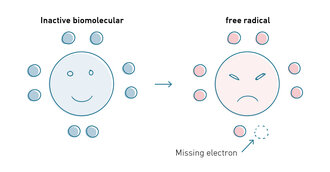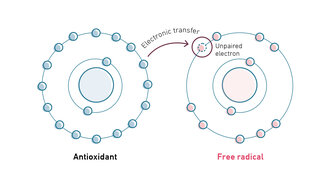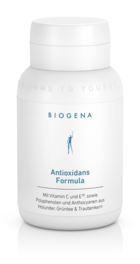Oxygen. It is as much a part of our lives as food, sleep or our consciousness. And you are not only surrounded by it, it is also inside you – involved in numerous oxidative processes. But it all depends on the dose – while we need a certain amount of oxidative substances to survive, too much of them is fatal. And we are not the only ones who are affected by this. Tomatoes lose their rich red colour and turn brown, as do flowers. Ultimately, if oxidative substances in your body become excessive, this leads to oxidative stress. In this blog post, we explain what causes this, why it is dangerous and what you can do to reduce oxidative stress.
Oxidative stress: what is it?
To understand what oxidative stress is, you first need to know what free radicals, also known as pro-oxidants, are. This is because they play an important role in this process. Free radicals are particularly reactive atoms and molecules that are formed during many metabolic processes (e.g. cellular respiration) and can be useful in defending against pathogens, for example. But they have one drawback: from a chemical point of view, they are missing at least one electron. This deficiency not only makes free radicals unstable, but also particularly aggressive. In order to be ‘complete’ again, they snatch an electron from the first reaction partner they find – yes, these rascals will stop at nothing! The result: the victim itself becomes a free radical and tries to retrieve the missing electron from its environment as quickly as possible. The result is a veritable battle for electrons. It goes without saying that your body does not like this unrest. It therefore keeps the free radicals under control as best it can with the help of radical scavengers (antioxidants) – and thus in balance.
However, your organism does not always succeed in doing this as you would like it to. Sometimes your antioxidant protection network is no longer able to keep these chaotic, reactive particles in check. The result: cells and metabolic processes come under oxidative attack. And that is exactly what is meant by oxidative stress. Oxidative stress occurs when the balance between free radicals and radical scavengers in the body is disrupted.


Symptoms: How oxidative stress can manifest itself
Most symptoms of oxidative stress are non-specific, which is why you should consult a medical professional if you suspect you may be affected. Various laboratory tests can give you certainty as to whether or not you are affected by oxidative stress. These tests either determine the level of free radicals in your body or examine the effects of possible oxidative stress.
The following may indicate an imbalance in your body and should be taken seriously:
- Fatigue
- Exhaustion
- Headaches
- Difficulty concentrating
- Skin problems (such as dry skin, redness or wrinkles)
- Weakened immune system
- Increased risk of chronic diseases
Consequences of oxidative stress
Why is it important not to ignore these early warning signs? Because oxidative stress can have further long-term consequences that are harmful to your health. Such an imbalance in your body destroys your cell structures and DNA, which can not only cause you to age more quickly, but also put you at increased risk of various chronic diseases. These include cancer, cardiovascular disease, neurodegenerative diseases such as Alzheimer's, and inflammation in various areas of your body. Serious skin problems can also develop, and you are generally more susceptible to bacteria, viruses and other pathogens.
Causes: How does oxidative stress develop?
The question you may now be asking yourself is: What specifically causes your body to run out of steam in this daily battle with free radicals? Or, to put it another way: How does oxidative stress actually arise? Well, first of all, you should know that it is completely normal and natural for free radicals to form in your metabolism. It only becomes a problem when these aggressive particles suddenly outnumber the antioxidants. Various environmental factors can contribute to this by putting strain on your antioxidant protection network. A single drag on a cigarette is enough to release billions of free radicals. In addition to nicotine, alcohol, stress, physical overexertion, too little sleep, infections, injuries, environmental toxins, unprotected sunbathing and air travel also increase the formation of free radicals and throw your defences out of balance.
How can oxidative stress be reduced?
The good news is that if you know the causes and risk factors of oxidative stress, you can take countermeasures. And fortunately, it's never too late to do so. Although you can't avoid all radical formers, it is possible to eliminate some of the culprits. So if you want to reduce oxidative stress, it's best to take the following advice to heart:
- Banish alcohol, nicotine and other drugs from your life
- Reduce stress and physical overexertion
- Make sure you get enough sleep and relaxation
- Avoid excessive sunbathing
- Avoid long-haul flights
- Protect yourself from environmental toxins
This will help ensure that the radical load does not steadily increase in weight and at the same time support your body's antioxidant defence team, which brings us to the next point: proper prevention. Because it is even better not to let oxidative stress develop in the first place.
How can you protect yourself from oxidative stress?
Whether oxidative stress occurs or not is primarily a question of balance. As you have already seen, a healthy lifestyle can be invaluable in this regard. This is because it helps to keep the formation of free radicals to a minimum. The three most important pillars are: nutrition, exercise and relaxation, as well as protection from environmental influences:
- Nutrition: A healthy diet rich in vital nutrients arms you with radical scavengers. Fresh fruit and vegetables are ideal for this. But sprouts, nuts and vegetable oils also serve up the protective substances you need on a silver platter. Well-known antioxidant nutrients include vitamin C and vitamin E, as well as zinc, selenium, copper and manganese. Together, they help to protect your cells from oxidative damage. These sought-after substances are found primarily in berries, nuts, tomatoes, broccoli, potatoes, carrots, garlic, peppers, vegetable oils and green tea.
- Exercise and relaxation: Make sure you exercise regularly, as this boosts your body's antioxidant capacity and improves blood circulation. However, it's not just about activity, but also its counterpart: relaxation. Make sure you take breaks, don't overwork yourself and get enough sleep. Regeneration helps you reduce oxidative stress.
- Protection from environmental influences: The sun and the air in particular should be treated with caution. Therefore, not only should you avoid excessive UV radiation, but you should also protect your body from air pollution and environmental toxins.
In addition, you can support your body with dietary supplements that provide important vital substances that help you combat oxidative stress. But beware: supplements are no substitute for a healthy diet – but they can help provide the body with targeted antioxidant equipment. A tool kit, if you will, that you can draw on at any time. Since antioxidants support each other in their effects and recycle after use, a combination of different antioxidant vital substances makes more sense than a one-sided, high-dose intake of individual substances.
Conclusion: Strengthen your own defence team
Stress is probably one of the most frequently used words in our fast-paced world. But not all stress is the same. Some forms of stress simmer slowly beneath the surface, only to eventually overwhelm you and put your health to the test. Oxidative stress is one such form of stress. It occurs when free radicals gain the upper hand in your body. What can you do about it? Strengthen your own defence team with a vitamin-rich diet that provides plenty of antioxidants, plenty of exercise and relaxation, and the right protective measures against environmental influences. So let's go!
Frequently asked questions about oxidative stress
Oxidative stress usually manifests itself in non-specific ways. The most important signs that may indicate oxidative stress include fatigue, exhaustion, headaches, difficulty concentrating, skin problems (such as dry skin, redness or wrinkles), a weakened immune system and an increased risk of chronic diseases. However, as the symptoms are not clear-cut, a laboratory diagnostic test should be carried out.
Important vitamins for combating oxidative stress are vitamins C and E. In addition, the vital substances zinc, selenium, copper and manganese can help to restore balance in the body.
A healthy lifestyle is crucial for reducing oxidative stress. This primarily includes a balanced diet with plenty of fruit, vegetables and wholemeal products to ensure the intake of important antioxidants such as vitamins C and E, as well as zinc, selenium, copper and manganese. In addition, regular exercise, sufficient relaxation and sleep, and avoiding harmful habits such as smoking and excessive alcohol consumption can help. Also, protect yourself from excessive UV radiation and air pollution.
Oxidative stress can be measured using various methods, either by directly determining the concentration of free radicals or by examining the effects of oxidative stress. The focus is on markers, i.e. measurable indicators of the presence of certain substances. These can be used to detect lipid or protein oxidation, DNA damage or antioxidants, for example.
Sources:
Sies H. Oxidative stress: a concept in redox biology and medicine. Redox Biol. 2015;4:180-3. doi: 10.1016/j.redox.2015.01.002. Epub 2015 Jan 3. PMID: 25588755; PMCID: PMC4309861. https://pubmed.ncbi.nlm.nih.gov/25588755/
Filomeni G, De Zio D, Cecconi F. Oxidative stress and autophagy: the clash between damage and metabolic needs. Cell Death Differ. 2015 Mar;22(3):377-88. doi: 10.1038/cdd.2014.150. Epub 2014 Sep 26. PMID: 25257172; PMCID: PMC4326572. https://pubmed.ncbi.nlm.nih.gov/25257172/
Kimball JS, Johnson JP, Carlson DA. Oxidative Stress and Osteoporosis. J Bone Joint Surg Am. 2021 Aug 4;103(15):1451-1461. doi: 10.2106/JBJS.20.00989. PMID: 34014853. https://pubmed.ncbi.nlm.nih.gov/34014853/
Jones DP. Radical-free biology of oxidative stress. Am J Physiol Cell Physiol. 2008 Oct;295(4):C849-68. doi: 10.1152/ajpcell.00283.2008. Epub 2008 Aug 6. PMID: 18684987; PMCID: PMC2575825. https://pubmed.ncbi.nlm.nih.gov/18684987/
van der Pol A, van Gilst WH, Voors AA, van der Meer P. Treating oxidative stress in heart failure: past, present and future. Eur J Heart Fail. 2019 Apr;21(4):425-435. doi: 10.1002/ejhf.1320. Epub 2018 Oct 19. PMID: 30338885; PMCID: PMC6607515. https://pubmed.ncbi.nlm.nih.gov/30338885/
Hybertson BM, Gao B, Bose SK, McCord JM. Oxidative stress in health and disease: the therapeutic potential of Nrf2 activation. Mol Aspects Med. 2011 Aug;32(4-6):234-46. doi: 10.1016/j.mam.2011.10.006. Epub 2011 Oct 15. PMID: 22020111. https://pubmed.ncbi.nlm.nih.gov/22020111/
Senoner T, Dichtl W. Oxidative Stress in Cardiovascular Diseases: Still a Therapeutic Target? Nutrients. 2019 Sep 4;11(9):2090. doi: 10.3390/nu11092090. PMID: 31487802; PMCID: PMC6769522. https://pubmed.ncbi.nlm.nih.gov/31487802/
Gorrini C, Harris IS, Mak TW. Modulation of oxidative stress as an anticancer strategy. Nat Rev Drug Discov. 2013 Dec;12(12):931-47. doi: 10.1038/nrd4002. PMID: 24287781. https://pubmed.ncbi.nlm.nih.gov/24287781/
Van Breusegem F, Remacle C. Oxidative stress responses in plants. Free Radic Biol Med. 2023 Aug 1;204:394. doi: 10.1016/j.freeradbiomed.2023.05.012. Epub 2023 May 15. PMID: 37196862. https://pubmed.ncbi.nlm.nih.gov/37196862/











